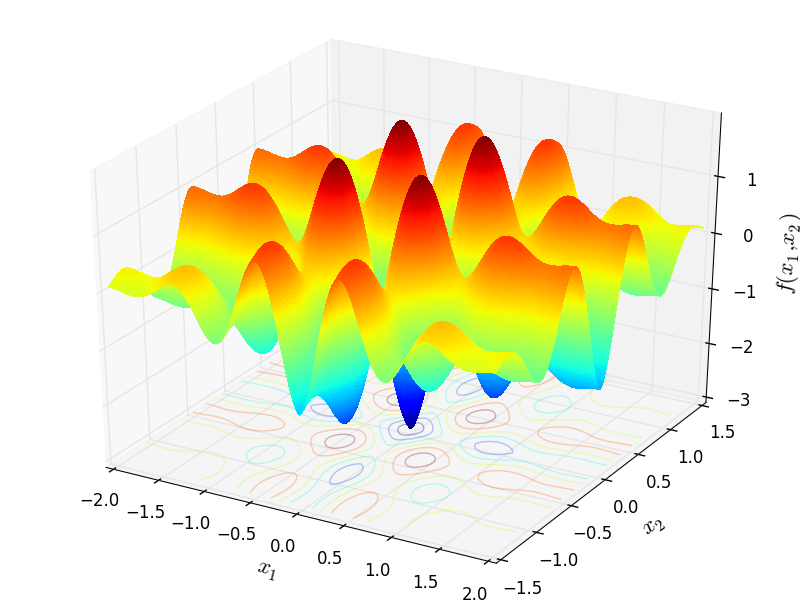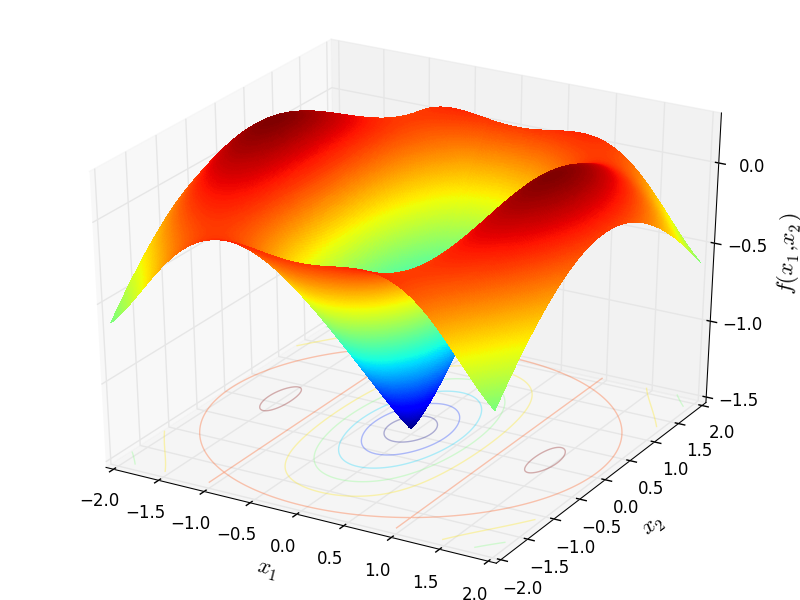Navigation
- index
- next |
- previous |

- Home »
- SciPy Test Functions Index »
- N-D Test Functions U
 N-D Test Functions U¶
N-D Test Functions U¶Ursem 1 objective function.
This class defines the Ursem 1 global optimization problem. This is a unimodal minimization problem defined as follows:

with ![x_1\in [-2.5, 3]](_images/math/0342daa11a35b74658b8423f18c2320dac059eef.png) and
and ![x_2\in [-2, 2]](_images/math/be82c0d42b768a04a676aeacbd3f14237c491dc6.png) .
.

Two-dimensional Ursem01 function
Global optimum:  for
for
![x = [1.69714, 0.0]](_images/math/3e7d4802410bf817c468336af4f699f4d62d531d.png)
Jamil, M. & Yang, X.-S. A Literature Survey of Benchmark Functions For Global Optimization Problems Int. Journal of Mathematical Modelling and Numerical Optimisation, 2013, 4, 150-194.
Ursem 3 objective function.
This class defines the Ursem 3 global optimization problem. This is a multimodal minimization problem defined as follows:

with ![x_1\in [-2, 2]](_images/math/dcd7b422c3e059a83a4c9ad211ebee4350b51ac1.png) ,
, ![x_2\in [-1.5, 1.5]](_images/math/243f164edcc42ea5edd7ad131e87fc2d63544bd2.png) .
.

Two-dimensional Ursem03 function
Global optimum:  for
for ![x = [0, 0]](_images/math/45f5b5de4a67315f59227449efaecb2b749a4db5.png)
Gavana, A. Global Optimization Benchmarks and AMPGO
Todo
Gavana and Jamil #157 disagree on the formulae here. Jamil squares the x[1] term in the sine expression. Gavana doesn’t. Go with Gavana here.
Ursem 4 objective function.
This class defines the Ursem 4 global optimization problem. This is a multimodal minimization problem defined as follows:

with ![x_i \in [-2, 2]](_images/math/3220cc226a0abf06f00e70257db97b5c754120f7.png) for
for  .
.

Two-dimensional Ursem04 function
Global optimum:  for
for ![x = [0, 0]](_images/math/45f5b5de4a67315f59227449efaecb2b749a4db5.png) for
for

Jamil, M. & Yang, X.-S. A Literature Survey of Benchmark Functions For Global Optimization Problems Int. Journal of Mathematical Modelling and Numerical Optimisation, 2013, 4, 150-194.
Ursem Waves objective function.
This class defines the Ursem Waves global optimization problem. This is a multimodal minimization problem defined as follows:
![f_{\text{UrsemWaves}}(x) = -0.9x_1^2 + (x_2^2 - 4.5x_2^2)x_1x_2
+ 4.7 \cos \left[ 2x_1 - x_2^2(2 + x_1)
\right ] \sin(2.5 \pi x_1)](_images/math/5a00249e0e26bffea1cb302a68c0715df3e5d63b.png)
with ![x_1\in [-0.9, 1.2]](_images/math/3341eab488a95d33c172483c6756acc0a3bb033a.png) ,
, ![x_2\in [-1.2, 1.2]](_images/math/a87ff29a6ad464173cb45320da3a4c9c1229dc73.png) .
.

Two-dimensional UrsemWaves function
Global optimum:  for
for ![x = [1.2, 1.2]](_images/math/b744b415fe03a69108bc11beff671fb9387d0ad3.png)
Jamil, M. & Yang, X.-S. A Literature Survey of Benchmark Functions For Global Optimization Problems Int. Journal of Mathematical Modelling and Numerical Optimisation, 2013, 4, 150-194.
Todo
Jamil #159, has an x_2^2 - 4.5 x_2^2 in the brackets. Why wasn’t this rationalised to -5.5 x_2^2? This makes me wonder if the equation is listed correctly?